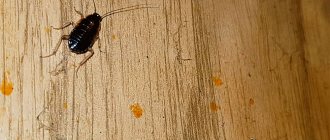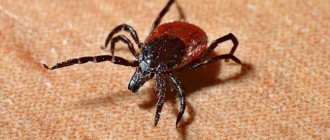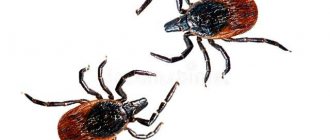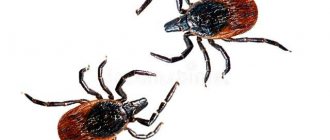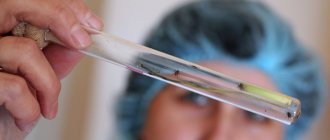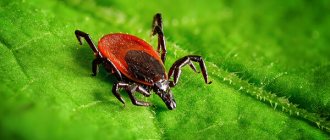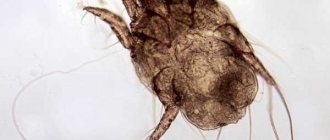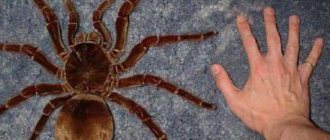Not only household members live with us in our houses and apartments, but also various types of insects. One of them is house ticks. Such a neighborhood is unpleasant and poses a threat to human health. It is very important that more than 150 types of parasites can live in a house, among which are:
- Dust;
- Predatory;
- Krysinykh;
- Lesnykh.
At the same time, dusty and predatory representatives of this class can constantly coexist with people, but forest ones are not permanent residents.
Have ticks already appeared?
Belarus is not the most tick-populated country, but our tick season begins early - in 2022, the first bites were recorded in the Brest region already in February. According to the Ministry of Health, the number of calls to the country's medical institutions regarding tick bites increased by 5% over the past year, and their number in nature increased by 8%.
This, by the way, is a pan-European trend due to climate change, an increase in the number of rodents and other reasons (now there are ticks even in the northern regions of Norway).
It is often said that there were no ticks in Belarus before, but this is not true: there were fewer of them because they were fought with aggressive chemicals, primarily with DDT, which is notorious for its side effects.
Modern chemical agents that kill ticks are much less toxic, but have less effect.
In a word, we need to get used to the fact that ticks are our neighbors, although unpleasant, and we need to know how to live next to them so as not to harm ourselves.
Infection of pets
If you find a tick on your pet, you should follow the same recommendations as in the case of a person. Do not touch the insect with bare hands or treat the bite site. Be sure to contact a veterinarian, as infection is also possible.
In the case of animals, they are attacked by parasites much more often, so you should use specialized means that prevent infection. In addition, it is not always possible to carry out inspections after each walk, and it is not so easy to notice them in wool.
When choosing a specialized product, you need to take into account the animal’s weight, age, presence of diseases, and general condition. An incorrectly selected drug can harm the animal.
Are all ticks dangerous?
In Belarus, the main carriers of human infections are representatives of ixodid ticks - the forest tick (also known as the dog tick) and the meadow tick. A tick goes through four stages in its development: egg, larva (0.5–1 mm in size), nymph (2–3.5 mm) and adult (7–15 mm).
All stages except the egg require blood feeding and can carry diseases. For clarity, we can say that the larva is similar in size to a small speck, the nymph is the size of a poppy seed, and the adult is a small spider the size of a sesame seed.
If a tick has sucked blood, it increases in size several times . At the beginning of summer, we mainly encounter small ticks (nymph stage), and at the end of summer, more often with adult individuals. The latter bite people less often because they are easier to notice and remove from the body or clothing.
Dust and predatory mites
In apartments, mites live in thick dust and feed on water-salt compounds that remain in it as a result of human activity. These representatives of arachnids do not parasitize warm-blooded creatures, but can cause them no less trouble than their saprophagous brothers. The excrement of little neighbors contains substances that cause allergies in humans. The disease can manifest itself in the most unexpected ways, for example:
- Rashes on the body;
- Attacks of suffocation;
- Allergic dermatitis.
These small insects cannot be seen without a microscope, since their size does not exceed 0.23 mm. They can place their nests either behind the sofa in a fair layer of dust or in bed. Microscopic parasites can be brought into the house after visiting a hairdresser, traveling on a train, or a laundry; they travel in feather beds and pillows, so doctors recommend not using feather bedding.
Along with small arthropods, the dust is inhabited by their larger fellow predators who eat them.
Dust mites in the house: what to do? First of all, create unfavorable conditions for their reproduction. Optimal conditions for the life of arthropods are relative humidity within 70% and air temperature 25°C. Reducing the humidity level to 40% and regularly cleaning dust in the premises will reduce the pest population. It is very important to wash bed linen in hot water and be sure to iron it without steam to prevent the fabric from picking up moisture. A rational solution would be to get rid of pillows, feather beds and blankets made from bird down or feathers.
Do ticks live in grass or trees?
Contrary to popular myth, ticks do not fall on us from above from trees, but live in the grass or on bushes, usually not rising above 1 m. They prefer shaded and damp places: the edges of mixed forests, paths, clearings, dead wood and brushwood. And ticks determine the approach of a person or animal by the concentration of carbon dioxide and thermal radiation.
As soon as the future owner approaches them closely, they cling to wool or clothing and crawl (always upward and quite quickly: 15–20 cm per minute), trying to get under the clothing and find a place to attach. And they find it more often where examination is difficult: the back, groin, axillary area, back of the neck and head.
Ticks do not bite painfully because they secrete special anesthetic substances into the wound. Further, the task of the tick is clear and prosaic: to get your blood - after all, it feeds on it. The entire process from crawling onto your pant leg to receiving your first red blood cells takes about two hours.
Natural factors that have a negative impact on the survival of parasites in the cold season
The survival rate of parasites in winter is affected by the amount of snow. If there is enough of it, they will not freeze in the warm bedding under a layer of snow. But if there is no snow cover and severe frosts persist for some time, then the ticks may die.
It is interesting that 30% of larvae and nymphs that begin to overwinter, and 20% of adults die in the absence of snow cover. Hungry ticks survive the winter better than those that ate blood before hibernation.
So how to protect yourself from ticks?
Knowing the mechanism of tick attachment, it becomes clearer how to protect yourself from it. It's simple: you need to prevent them from crawling under your clothes.
- There should be no gaps between pants and shoes, pants and outerwear.
- It is better to keep the cuffs and collar of the shirt buttoned.
- It is better to choose clothes not with buttons (you can crawl closer to you between them), but with zippers.
- It is better to choose a light color of clothing - the tick is easier to see on it. A camouflage jacket and dark pants are a very bad option for the forest.
- It is better to cover the hair on your head with a hood or scarf.
- The degree of protection can be increased by using acaricidal agents and repellents to treat clothing (possibly at the same time).
- Check yourself and each other every hour.
- If possible , do not sit or lie on the grass - the tick can immediately cling to the upper part of your clothing.
When you return home, do not bring in clothes or plants you collected in the forest - ticks may be there too. It is better to put clothes in the sun or in a drying cabinet for a while or wash them - this will help disinfection.
It is also important to take a shower after going to a potentially dangerous place: you cannot wash off an attached tick with water, but for those who are still preparing to do this, you can. In addition, a shower is an opportunity to carefully examine yourself for uninvited guests.
Does the vaccine save?
The tick-borne encephalitis vaccine is usually given to those who are at risk of infection. For example, people whose work involves being in the forest. Absolutely all people do not need it. It will also not be possible to get vaccinated the day before a trip to the forest, since it is necessary to complete the entire vaccination course against tick-borne encephalitis two weeks before leaving for an unfavorable territory. The vaccine is free and is included in the list of services under the compulsory medical insurance policy.
When is the best time to get vaccinated against encephalitis? More details
Are animals a risk factor?
The need to feed on blood has developed in the tick in the process of evolution a very wide range of donor hosts - from rodents and birds to dogs and humans (for example, in the USA the most common tick is called the deer tick).
Therefore, dog owners need to be especially careful: ticks that stick to their pets while walking can spread to humans.
Thus, American scientists who studied households in areas where ticks are often found found that if there is a dog or cat in the house that roams freely on the street, then the likelihood of finding a tick on one of the household members is twice as high as in families without pets.
To be fair, it should be noted that more frequent exposure to ticks on oneself has not led to an increase in the incidence of tick-borne infections among pet owners.
What harm do they cause to humans?
Since bed mites do not feed on human blood and do not leave bites on the skin, when present in the house in minimal quantities they do not cause significant harm. But the danger increases in direct proportion to the increase in the population indoors. The fact is that bed mite feces and the chitinous cover shed during molting contain a strong allergen that can cause acute painful reactions in some people.
One individual defecates about 25 times a day.
First of all, we are talking about manifestations from the respiratory system. Doctors say that inhaling the feces and chitin of dust mites, which include bed mites, is one of the most common causes of asthma. Skin manifestations are also observed - the formation of bumps and scratches, causing severe itching. This brings emotional discomfort to a person. Constant proximity can lead to chronic irritability or insomnia. Therefore, the destruction of bed mites should begin immediately after signs of their presence in the rooms appear.
How can you protect your pets from ticks?
Alexander Ocheretny
deputy editor-in-chief of the newspaper "Palyaunichy i rybalo"
“I’ve been keeping dogs all my life, but I’ve started protecting them from ticks in completely radical ways over the last 18 years,” says Alexander. – Previously, you could forget to treat the dog and hope for luck, but now no, it won’t work that way.
For example, I can remove about 50 ticks at a time from my current dog; You yourself understand that an unprotected dog is now a suicide bomber. Moreover, if we talk about means of protection, then I am inclined to those drugs that are taken orally by the dog: I feel calmer when the dog is protected for a long time - the ticks cling, but die on it.
On a short-haired and light-colored dog they are better visible - ticks are black or reddish in color, they are easier to collect. For example, my previous dog, Drathaar, was “mite-colored”, plus thick fur - it was difficult. And now I have Italian spinone: it’s light, and it’s much easier.
A tick has attached itself - what to do?
If you find a tick attached to you, then there are several options on what to do: you can go to the nearest emergency room, hospital or clinic , where they will help you, or you can remove it yourself (this saves time).
How to do it:
- Using a special device (sold in pharmacies and hardware stores).
- Using thin tweezers: you need to grab the tick as close to the skin as possible and confidently pull up (you can slightly rotate the tweezers around its axis).
- Using a thin strong thread , which is pulled into a knot as close to the skin as possible and, turning around a vertical axis, the tick is removed (option for advanced ones).
Ideally, you need to remove the entire tick from the body without damaging it: if you remove it carelessly, you can squeeze out pathogens from it. For the same reason, you should not touch the tick’s abdomen.
Important: the option of applying vegetable oil to the tick to block its breathing and force it to let go of the person does not work - the tick will not fall off, but, choking, may vomit infected blood into the wound.
Do bed ticks bite people?
If a person suspects mattress mites in his home, he begins to study in detail information about bites and signs of the presence of parasites.
It is the mattress tick that is not capable of biting a person due to its small size, and they are also not carriers of infections. The tick that lives in pillows also does not bite, but harms humans through exposure to its waste products:
- After molting, insect cuticle remains in the pillow.
- Substances produced by mites.
- Proteins contained in pest feces.
People prone to allergies should be especially vigilant and monitor for mites.
If symptoms occur, you should definitely visit a doctor, as advanced allergies can develop into more serious chronic diseases. Bed mite bites are often confused with bedbug bites. In fact, bedbugs have very characteristic bites that are difficult to confuse with any others - there are many of them and they are located in groups, the skin around them swells a little and a slight seal appears.
What diseases do ticks carry in Belarus?
Ticks, like you and me, have bacteria and viruses living inside them: pathogens that cause diseases in humans and animals.
Moreover, the presence of 2-3 infectious agents in a tick at the same time is not uncommon - in some areas the proportion of such ticks among their entire population reaches 30%.
According to the Ministry of Health, we have 9 “tick-borne” infections, but the most relevant of them are tick-borne borreliosis (Lyme disease) and tick-borne encephalitis. The last one is the most unpleasant.
In addition to a tick bite, you can also become infected with such encephalitis by consuming raw goat milk (ticks bite goats and infect them, and they accumulate the virus in the milk).
Fortunately, in Belarus there is a “western” type of encephalitis - much milder than the “eastern” one, often with an asymptomatic course of the disease (especially in children).
If there are symptoms, they range from flu-like (with high fever, headache, nausea , etc.) or acute meningitis-like (also with high fever, headache, photophobia , etc.) to brain and spinal lesions brain (occurs less often). Tick-borne encephalitis is quite rare in Belarus: over the past 15 years, 1262 cases have been identified in adults and 95 in children.
But there is a way to minimize even this small risk through vaccination, which is 95% effective. In Belarus, those who work in Belovezhskaya Pushcha or the Berezinsky Nature Reserve are required to be vaccinated against tick-borne encephalitis. If you often visit these places, then it also makes sense for you to think about getting vaccinated.
When it comes to Lyme borreliosis, it is important to remember that it is a bacterial infection. That is, when a doctor prescribes antibiotics after a tick bite, he is mainly dealing with the prevention of this disease - other bacterial infections carried by ticks are much less common.
If infection with Borrelia occurs, then 3–30 days (usually 7–14) after the bite, redness appears in its place, which expands towards the periphery and turns pale in the center. At this stage, the infection responds well to antibiotic therapy.
If the disease is not recognized or proceeds without redness, then after 4-6 weeks damage to the heart, joints and even the nervous system may develop. At this stage, antibacterial treatment is also quite effective.
Unfortunately, a vaccine against Lyme disease has not been developed. Prevention of infection is carried out by using antibacterial drugs after a tick bite.
How long does a tick drink human blood?
The parasite can fall off at any time after it has become attached to the skin. The duration of meals often varies from a few hours to several weeks. On average, the pest remains on the human body for 3-8 days, the maximum period is 14 days. A tick that has drunk blood falls off on its own. But this does not always happen within the specified time frame.
The duration of the meal is also determined by how hungry the parasite is. If it has not been fed for several months/years, it may well remain on the skin much longer. Sooner or later, the parasite filled with blood disappears. During this time, it will most likely be detected, since within a few weeks of parasitism this pest develops more severe symptoms.
Sometimes
– signs of more dangerous diseases (borreliosis, tick-borne encephalitis).
Duration of tick feeding
Do you always need to take an antibiotic after a tick bite?
This is a question with which it is better to consult a doctor.
Considering that the transmission of infection requires the fulfillment of several conditions at once, and side effects from the use of antibiotics are more common than the disease itself, emergency antibiotic prophylaxis after a tick bite is not carried out in Europe.
In our country, this issue is regulated by Order of the Ministry of Health No. 338 of 2016, which states that emergency antibiotic prophylaxis is carried out individually as prescribed by a health worker - but no later than 72 hours after a tick bite.
Therefore, in situations where the tick has been on a person for more than 12 hours, appears to be engorged, and was difficult to remove, it is worth discussing the use of medications with a doctor you trust.
In any case, after an encounter with a tick, you should monitor the site of the bite for a month, as well as the general condition of the victim. The appearance of redness at the site of contact or high temperature with aching bones, nausea and (or) headache are reasons to consult a doctor.
Prevention of bed mites.
It is quite difficult to destroy ticks, so to avoid their appearance it is better to carry out preventive measures that require less effort.
First of all, you should get rid of natural wool carpets, blankets and feather pillows. Replace woolen items with synthetic ones, as they are not as attractive to ticks. Put away stuffed animals, but if this is not possible, wash and steam them regularly. Bed linen should be changed once a week, more often, but not less often. Try to dry washed clothes in the fresh air, which is especially useful in winter. Furniture with textile elements and upholstery must be cleaned and steamed regularly. Periodically wipe floors, cabinets and other surfaces with the saline solution we discussed above. If your home is humid, then you need to reduce this level; dry air, as you know, is not a favorable environment for ticks. Also keep an eye on the temperature in your rooms; the ideal level should not be higher than 22 degrees. By following these recommendations, you can prevent ticks from multiplying and they will not bother you.
Should I submit a tick for analysis?
Modern research answers this question in the negative, since the percentage of detection of infectious agents in ticks has virtually no effect on the risk of human disease, but only increases uncertainty and creates unnecessary anxiety.
Therefore, as the famous pediatrician blogger Roman Shiyan said, “it is more reasonable to examine not a tick, but a person if he is suspected of having a corresponding disease.”
Tick activity period: when does it start and how long does it last?
As soon as the air temperature rises above +3 degrees in the spring, the life processes of ticks begin to work, they begin to look for a food source. As long as the temperature outside is above zero, they lead an active lifestyle. But in winter, significant changes occur in their bodies.
The peak activity of ticks is the warm season.
Diapauses in the life of ticks
Diapause is an intermediate state between hibernation and suspended animation. Ticks remain in this state for long winter months, thanks to which they do not die.
During this period, they do not feed, all life processes slow down, and the parasites receive the minimum amount of oxygen necessary for life. They can remain in this state even for several years if the parasite accidentally ends up in an area where the temperature does not rise above zero degrees for a long time. And under favorable conditions, exit diapause and continue its life cycle.
Have you become the prey of a tick?
Yes, it happened No, fortunately
